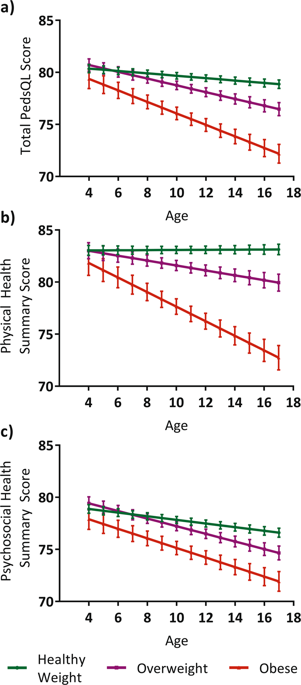International Journal of Obesity ( IF 4.2 ) Pub Date : 2020-01-16 , DOI: 10.1038/s41366-020-0529-3 Anagha Killedar 1 , Thomas Lung 1, 2 , Stavros Petrou 3, 4 , Armando Teixeira-Pinto 1 , Eng Joo Tan 1 , Alison Hayes 1

|
Background
Overweight and obesity in children is associated with poor health-related quality of life (HRQoL), but the nuances of this relationship across different age and socio-demographic groups are not well-established. The aim of this study is to examine how the association between weight status and HRQoL changes with age and socioeconomic position (SEP) throughout childhood and adolescence.
Methods
We used data from the Longitudinal Study of Australian Children (LSAC), a cohort study in which children were interviewed biennially from ages 4 to 17 years over seven waves of data. Measurements of HRQoL (using PedsQLTM), body mass index (BMI), and socio-demographic characteristics were collected at each interview. Of the 4983 children recruited into the study, we included data from 4083 children (a total of 24,446 observations). We used generalised estimating equations to assess whether age and SEP modified the association between weight status and HRQoL, after controlling for sex, long-term medical condition, language spoken to child and maternal smoking status.
Results
Age was a significant modifier of the association between weight status and HRQoL, with adjustment for known predictors of HRQoL (P < 0.001). At age 4, children with obesity had, on average, a 0.99 (95% CI 0.02–1.96) point lower PedsQL total score than children at healthy weight. This difference became clinically important by age 9 at 4.50 (95% CI 3.86–5.13) points and increased to 6.69 (95% CI 5.74–7.64) points by age 17. There was no evidence that SEP modified the relationship between weight status and HRQoL (P > 0.05).
Conclusions
Our results demonstrate that the relationship between overweight and obesity status and poor HRQoL is strengthened with increasing age through childhood and adolescence, but is not affected by SEP. Paediatricians, researchers and carers of children with obesity should acknowledge HRQoL outcomes, particularly for older children and adolescents.
中文翻译:

儿童期和青春期体重状况和与健康相关的生活质量:年龄和社会经济地位的影响
背景
儿童超重和肥胖与较差的健康相关生活质量 (HRQoL) 相关,但这种关系在不同年龄和社会人口群体之间的细微差别尚不明确。本研究的目的是检查体重状况和 HRQoL 之间的关联如何在整个儿童期和青春期随年龄和社会经济地位 (SEP) 变化。
方法
我们使用了来自澳大利亚儿童纵向研究 (LSAC) 的数据,这是一项队列研究,其中每两年一次对 4 至 17 岁的儿童进行七轮数据访谈。在每次访谈中收集HRQoL(使用 PedsQL TM)、体重指数 (BMI) 和社会人口学特征的测量值。在招募到研究中的 4983 名儿童中,我们包括了来自 4083 名儿童的数据(总共 24,446 次观察)。我们使用广义估计方程来评估年龄和 SEP 是否改变了体重状况和 HRQoL 之间的关联,在控制了性别、长期医疗状况、与儿童交谈的语言和母亲吸烟状况之后。
结果
年龄是体重状况与 HRQoL 之间关联的重要调节因子,并调整了已知的 HRQoL 预测因子(P < 0.001)。在 4 岁时,肥胖儿童的 PedsQL 总分平均比健康体重儿童低 0.99 (95% CI 0.02–1.96) 点。这种差异在 9 岁时变得具有临床意义,为 4.50 (95% CI 3.86–5.13) 点,到 17 岁时增加到 6.69 (95% CI 5.74–7.64) 点。没有证据表明 SEP 改变了体重状态和 HRQoL 之间的关系( P > 0.05)。
结论
我们的研究结果表明,超重和肥胖状态与较差的 HRQoL 之间的关系随着儿童和青春期年龄的增长而加强,但不受 SEP 的影响。儿科医生、研究人员和肥胖儿童的照顾者应该承认 HRQoL 结果,特别是对于年龄较大的儿童和青少年。











































 京公网安备 11010802027423号
京公网安备 11010802027423号